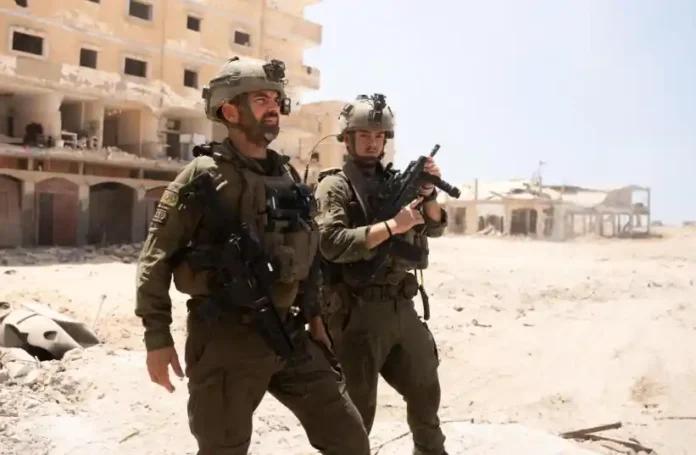Rafah, Gaza Strip – A white cat roamed across the rubble-strewn landscape of Rafah’s Shabura refugee camp, the sole civilian remnant in what was once a bustling neighborhood near the Egyptian border.
The devastation, marked by bullet-riddled signs and half-destroyed buildings, told a story of recent conflict. Until the start of May, this area had been filled with Palestinian residents.
The remnants of a Sonol gas station sign hung precariously over the ruins, and concrete structures stood reduced to mere skeletal frames amidst heaps of debris. Sand had overtaken what were once paved roads, transforming Shabura into a desolate dust bowl.
On Tuesday, the Israel Defense Forces (IDF) transported a small group of reporters in a Humvee into this war-torn landscape. Nahal Brigade Commander Colonel Yair Zuckerman briefed them on Hamas’s entrenchment in the civilian areas.
This marked the 41st day of the battle for Rafah, as Zuckerman spoke from one of the few relatively intact buildings in the neighborhood, its occupants long since fled.
Colonel Zuckerman, dressed in khaki and a flak jacket, met the press in what used to be a spacious second-floor apartment. The windows were draped with blankets, and a lone civilian piece of furniture, a small sofa with wooden trim and light brown fabric, stood out in the room.
Directions in Hebrew—North, South, East, and West—were scrawled on the white walls by soldiers. A generator hummed, occasionally interrupted by distant explosions, as Zuckerman laid out the IDF’s strategy on a computer-filled table.
“Rafah is chalk-filled with tunnels,” Zuckerman explained, mapping out the intricate network of subterranean passages used by Hamas. He showed a photograph illustrating his point: an open closet door revealing a hole in the concrete wall.
“During the last days alone, I found 17 tunnels,” he added, noting that nearly every home had one, connecting the neighborhood into a vast underground labyrinth.
This complex network poses significant challenges for the IDF, with homes booby-trapped and wired with explosives that can be detonated remotely. Zuckerman referenced a tragic incident from the previous week when four IDF soldiers were killed by such a trap in a seemingly safe house.
“It’s slow and painstaking,” he said of the methodical, inch-by-inch combat, which involves fighting both above and below ground.
Despite the arduous process, Zuckerman emphasized the importance of the IDF’s mission to demilitarize the area, citing the discovery of weapons caches, rocket-propelled grenades, and long-range rockets.
The soldiers, he stressed, understood the gravity of their task. “This existential problem rests on their shoulders,” Zuckerman said, describing a series of small, incremental successes that would ultimately lead to a decisive victory.
While he refrained from predicting how long the operation might take, he underscored the necessity of completing the mission. “We don’t want to leave until we have solved the problem,” he asserted.
As the IDF continues its efforts in Rafah, the once-vibrant Shabura refugee camp stands as a stark reminder of the conflict’s toll, its empty silence broken only by the hum of generators and distant echoes of war.
This article was created using automation technology and was thoroughly edited and fact-checked by one of our editorial staff members

